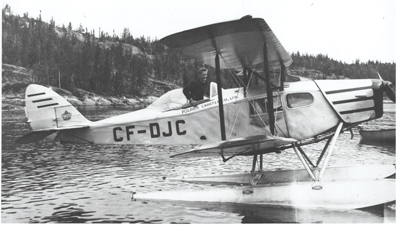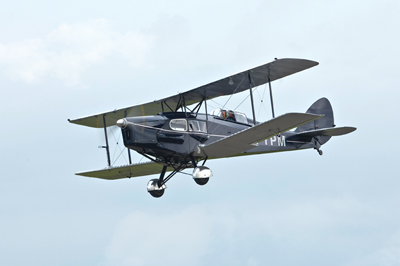
Features
History
100 Years of Powered Flight in Canada: September October 2009
Out of the famous stable of de Havilland aircraft, the Tiger Moth was the best known and most widely used in Canada; its half-brother, the Fox Moth, was the least known.
September 29, 2009 By Raymond Canon
Out of the famous stable of de Havilland aircraft, the Tiger Moth was the best known and most widely used in Canada; its half-brother, the Fox Moth, was the least known. That should not be taken as a criticism of the latter; unlike the Tiger Moth, which acted as a basic trainer for untold thousands of embryonic pilots before and during the Second World War, the Fox Moth enjoyed only limited production in both Great Britain and Canada.
 |
|
| Max Ward in CF- DJC (Photo courtesy of the Canadian Air & Space Museum)
|
Since the two aircraft looked so much alike, it is only logical to assume that they shared the same designer. So it was that A.E. Hagg followed his success in Great Britain in 1931 with the Tiger Moth by immediately turning to the Fox Moth in response to a demand for a lightweight transport aircraft. The two aircraft may have been for totally different purposes but that did not stop Hagg from borrowing a number of Tiger parts for the Fox. Both had wood frames, the Tiger’s being made of spruce while the Fox’s, plywood.
Only 85 Fox Moths were built in Great Britain before the war, but it was, in its own way, just as successful as its half-brother. The purpose, as indicated above, was to serve as a light passenger and/or freight aircraft and, as such, found instant favour. The pilot sat in a raised seat, behind, not in front, of the passenger cabin. The latter normally contained four seats but could be reduced to three when weight was a problem.
This story might have started and ended in Great Britain if it had not been for the fact that, after the aircraft had gained its stellar reputation among its British users, the prototype was shipped to the de Havilland plant in Toronto. Enough interest was shown for the company to build two more in Toronto. Finally, an additional eight crossed the ocean to meet Canadian demand.
 |
|
| Beautifully restored VWC Fox Moth piloted by Dave Hadfield. (Photo courtesy of Peter Handley, Vintage Wings of Canada)
|
After so many years I found it difficult to locate anybody connected with these early Fox Moths. However, a witness was finally found in Capt. Frank Bradley, who early in the war had earned his wings as a pilot in the RCAF, and was subsequently seconded to Canadian Pacific Airlines to train navigators at what is today Quebec City Airport.
“It was there,” Bradley recalls, “that one privately-owned three seater Fox Moth appeared periodically at the airport for maintenance.”
“The aircraft,” he continued, “flew in and out of a grass field near Tadoussac at the mouth of the Saguenay River and was employed, among other things, to transport people and cargo across the St. Lawrence River, 30 miles wide at that point.”
“In the winter,” he concluded, “its wheels were replaced by skis. It was the object of intense curiosity by the airmen at our base since none of them had seen anything like it before.”
After the war, a further 54 were built in Toronto and the Fox became popular, among other things, as a bush plane and air ambulance. The characteristics that attracted Canadian flyers had already become well known to their British counterparts in the 1930s. The Fox was not as large or rugged as its chief Canadian-designed competitor, the Noorduyn Norseman, but it was certainly very popular in the roles it played.
Perhaps its best-known owner was Max Ward, featured in the last issue of Wings, who made it his first purchase for his planned airline. The Canada Aviation Museum in Ottawa has on display an authentic version of the aircraft that so attracted Ward, if any readers wish to see one. It was Ward himself who bought and then donated it to the museum in 1990.